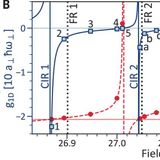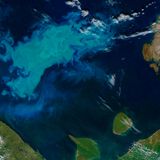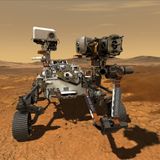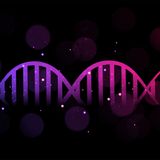RECENT ARTICLES

Topological pumping of a 1D dipolar gas into strongly correlated prethermal states
You are currently viewing the abstract.AAAS login provides access to Science for AAAS members, and access to other journals in the Science family to users who have purchased individual subscriptions.Log in via OpenAthens.Log in with your institution via Shibboleth.Download and print this article for your personal scholarly, research, and educational use.Buy a single issue of Science for just $15 USD.Most nonequilibrium, many-particle systems eventually reach a thermal state. However, some one-dimensional quantum systems do not thermalize, although they may settle into a long-term...…You are currently viewing the abstract.AAAS login provides access to Science for AAAS members, and access to other journals in the Science family to users who have purchased individual subscriptions.Log in via OpenAthens.Log in with your institution via Shibboleth.Download and print this article for your personal scholarly, research, and educational use.Buy a single issue of Science for just $15 USD.Most nonequilibrium, many-particle systems eventually reach a thermal state. However, some one-dimensional quantum systems do not thermalize, although they may settle into a long-term...WW…
An open letter to the Stanford community and the Stanford Athletics family | Stanford News
July 8, 2020Marc Tessier-Lavigne, PresidentPersis Drell, ProvostBernard Muir, Director of AthleticsOne of Stanford’s great sources of pride is our intercollegiate athletics program. Over the course of our storied history, through innumerable days of challenge, triumph and joy, our student-athletes have set the standard for exceptional achievement in both academics and athletics. Cheering on the Cardinal is an integral part of life at Stanford, and the commitment and dedication of our student-athletes serve as an inspiration for fans and followers well beyond The Farm.As you may know,...…July 8, 2020Marc Tessier-Lavigne, PresidentPersis Drell, ProvostBernard Muir, Director of AthleticsOne of Stanford’s great sources of pride is our intercollegiate athletics program. Over the course of our storied history, through innumerable days of challenge, triumph and joy, our student-athletes have set the standard for exceptional achievement in both academics and athletics. Cheering on the Cardinal is an integral part of life at Stanford, and the commitment and dedication of our student-athletes serve as an inspiration for fans and followers well beyond The Farm.As you may know,...WW…

‘Regime shift’ happening in the Arctic Ocean | Stanford News
July 9, 2020 Stanford scientists find the growth of phytoplankton in the Arctic Ocean has increased 57 percent over just two decades, enhancing its ability to soak up carbon dioxide. While once linked to melting sea ice, the increase is now propelled by rising concentrations of tiny algae.By Josie GarthwaiteScientists at Stanford University have discovered a surprising shift in the Arctic Ocean. Exploding blooms of phytoplankton, the tiny algae at the base of a food web topped by whales and polar bears, have drastically altered the Arctic’s ability to transform atmospheric carbon into...…July 9, 2020 Stanford scientists find the growth of phytoplankton in the Arctic Ocean has increased 57 percent over just two decades, enhancing its ability to soak up carbon dioxide. While once linked to melting sea ice, the increase is now propelled by rising concentrations of tiny algae.By Josie GarthwaiteScientists at Stanford University have discovered a surprising shift in the Arctic Ocean. Exploding blooms of phytoplankton, the tiny algae at the base of a food web topped by whales and polar bears, have drastically altered the Arctic’s ability to transform atmospheric carbon into...WW…

Donald Kennedy, Stanford's eighth president, dead at 88 | Stanford News
April 21, 2020 Donald Kennedy, who served as Stanford’s eighth president, helped set the stage for its transformation into one of the nation’s top research universities.By Kathleen J. SullivanDonald Kennedy, a neurobiologist who became the eighth president of Stanford in 1980 and helped set the stage for its transformation into one of the nation’s top research universities during his 12 years in office, died April 21, 2020, of COVID-19 at Gordon Manor, a residential care home in Redwood City where he resided for the past two years.Donald Kennedy, president emeritus and Bing Professor of...…April 21, 2020 Donald Kennedy, who served as Stanford’s eighth president, helped set the stage for its transformation into one of the nation’s top research universities.By Kathleen J. SullivanDonald Kennedy, a neurobiologist who became the eighth president of Stanford in 1980 and helped set the stage for its transformation into one of the nation’s top research universities during his 12 years in office, died April 21, 2020, of COVID-19 at Gordon Manor, a residential care home in Redwood City where he resided for the past two years.Donald Kennedy, president emeritus and Bing Professor of...WW…

Promising signs for Perseverance rover in its quest for past Martian life | Stanford News
April 23, 2020 New research indicates river delta deposits within Mars’ Jezero crater – the destination of NASA’s Perseverance rover on the Red Planet – formed over time scales that promoted habitability and enhanced preservation of evidence.By Danielle Torrent TuckerUndulating streaks of land visible from space reveal rivers once coursed across the Martian surface – but for how long did the water flow? Enough time to record evidence of ancient life, according to a new Stanford study.NASA’s Mars Perseverance Rover, expected to launch in July 2020, will land in Jezero crater, pictured here....…April 23, 2020 New research indicates river delta deposits within Mars’ Jezero crater – the destination of NASA’s Perseverance rover on the Red Planet – formed over time scales that promoted habitability and enhanced preservation of evidence.By Danielle Torrent TuckerUndulating streaks of land visible from space reveal rivers once coursed across the Martian surface – but for how long did the water flow? Enough time to record evidence of ancient life, according to a new Stanford study.NASA’s Mars Perseverance Rover, expected to launch in July 2020, will land in Jezero crater, pictured here....WW…

How cosmic rays may have shaped life | Stanford News
May 20, 2020 Physicists propose that the influence of cosmic rays on early life may explain nature’s preference for a uniform “handedness” among biology’s critical molecules.By Taylor KubotaBefore there were animals, bacteria or even DNA on Earth, self-replicating molecules were slowly evolving their way from simple matter to life beneath a constant shower of energetic particles from space.Magnetically polarized radiation preferentially ionized one type of “handedness” leading to a slightly different mutation rate between the two mirror proto-lifeforms. Over time, right-handed molecules...…May 20, 2020 Physicists propose that the influence of cosmic rays on early life may explain nature’s preference for a uniform “handedness” among biology’s critical molecules.By Taylor KubotaBefore there were animals, bacteria or even DNA on Earth, self-replicating molecules were slowly evolving their way from simple matter to life beneath a constant shower of energetic particles from space.Magnetically polarized radiation preferentially ionized one type of “handedness” leading to a slightly different mutation rate between the two mirror proto-lifeforms. Over time, right-handed molecules...WW…
- Total 6 items
- 1